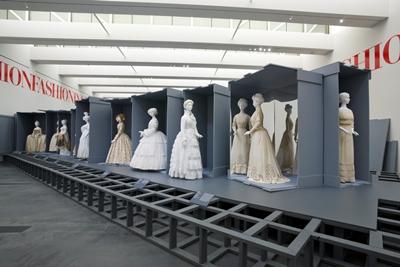Two years since the debut of Fashioning Fashion: European Dress in Detail, 1700–1915 at LACMA, the exhibition, which explored the changes in fashionable dress spanning two centuries, is again on view in Berlin at the Deutsches Historisches Museum (DHM) until July 29. Though the installations at both LACMA and DHM were divided into identical thematic sections—Timeline, Textiles, Tailoring, and Trim—each institution displayed the art using its own unique exhibition designs.

Woman’s Timeline display at LACMA, showcasing the mannequins in crates
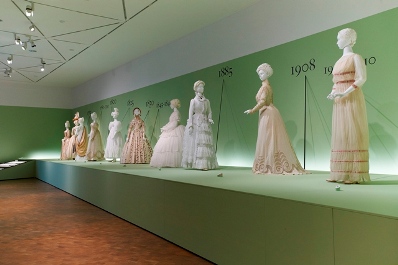
The same display at the DHM sets the mannequins on a green, back-lit platform with ribbons pointing to their year of fashionableness
The original Fashioning Fashion at LACMA inaugurated both the grand opening of the Resnick Pavilion as well as the museum's groundbreaking acquisition of a major collection of European men's, women's, and children's garments and accessories. This celebratory mood was reflected in the exhibition design concept, staged by renowned Italian opera designers Pier-Luigi Pizzi and Massimo Pizzi Gasparon, where the historic fashions were displayed emerging from gray shipping crates. This “uncrating” instilled a sense of discovery in the visitors who experienced the Resnick Pavilion and the collection for the first time.

Tailoring display at LACMA
In contrast, the DHM exhibition design was conceived by Belgian scenographer Bob Verhelst, who chose four harmonious shades of green for the installation, inspired by a vivid hue he saw in an eighteenth-century French château. This presentation also did away with the glass vitrines that are typical in most fashion exhibitions in Europe, allowing visitors a more intimate viewing experience.
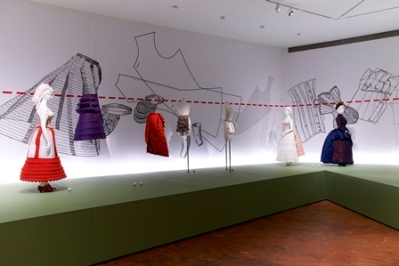
Tailoring display at the DHM with green platforms and wall graphics of historic clothing patterns
Touring an exhibition comprised of dressed mannequins and complicated mounts required much advance planning. A LACMA team of two curators, a conservator, and an installation specialist traveled to Berlin to install Fashioning Fashion in just four weeks, aided by five talented conservators from the host institution. In contrast, the preparation for LACMA’s presentation took many months to complete, in addition to a full six weeks devoted to gallery installation alone. The DHM installation was faster in part due to shipping the mannequins to Berlin with all of their necessary padding and understructures already in place, making the dressing process much less time consuming. (See this Unframed post about the mannequin preparation for the exhibition.)

At the beginning of the LACMA installation, many of the mannequins required padding and understructure—all from scratch— in order to accurately display the historic dress in the exhibition. A single mannequin would take at least one day to complete.
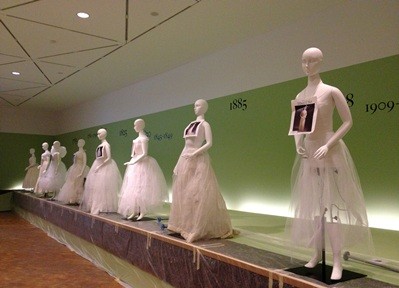
The mannequins arrived at the DHM with all of their original padding and understructure intact, making for a much speedier installation. This allowed for up to three mannequins to be dressed per day.
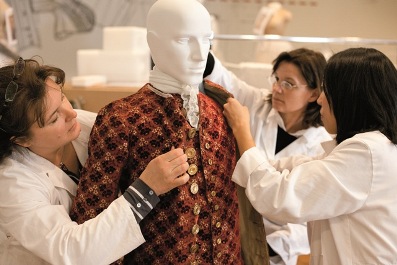
During the first week of installation at the DHM, LACMA installation specialist Sophia Gan dresses an eighteenth-century mannequin with the help of DHM conservators Judith Zimmer and Jutta Peschke.

In the last week of installation, the Men’s Timeline platform at the DHM—beginning with the red velvet eighteenth-century suit—receives its final dressed mannequin.

After four weeks of installation and a few finishing touches, the Men’s Timeline section is finally completed and ready for visitors.
The installation at DHM was hard work but very rewarding; a short documentary film about the making of Fashioning Fashion at DHM shows highlights of the process.
The LACMA team will soon travel back to Berlin to deinstall Fashioning Fashion and prepare for its final venue on the exhibition’s international tour in the birthplace of haute couture itself—Paris. Les Arts Décoratifs, Musée de la Mode et du Textile in the Palais du Louvre will host Fashioning Fashion from December 13, 2012 – April 14, 2013. Vous y voir!
Clarissa Esguerra, Assistant Curator, and Leigh Wishner, Curatorial Assistant, Costume and Textiles
Photos 2, 4, and 7: © Detlef Eden, Deutsches Historisches Museum; all others © 2012 Museum Associates/LACMA



